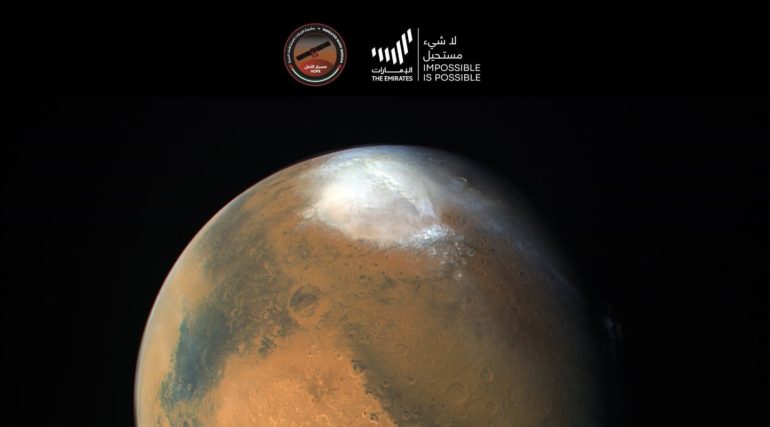The Emirates Mars Mission, the first interplanetary exploration undertaken by an Arab nation, has made the first observations of a new type of proton aurora around Mars. The spatially variable ‘patchy’ proton aurora potentially triggers new insights into unexpected behaviors in the Martian atmosphere. The EMM team has worked together with NASA’s MAVEN (Mars Atmosphere and Volatile Evolution) mission to fully characterize these observations. The combination of EMM’s unprecedented global aurora images with MAVEN’s simultaneous local plasma observations opens up new avenues for understanding the drivers of Mars’ enigmatic aurora.
This new patchy type of proton aurora is formed when the solar wind directly impacts Mars’ dayside upper atmosphere and emits ultraviolet light as it slows down. It was discovered in snapshots of the dayside disk obtained by the Emirates Mars Ultraviolet Spectrometer (EMUS), which observes the planet’s upper atmosphere and exosphere, scanning for variability in atmospheric composition and atmospheric escape to space. The aurora manifests as bright regions scattered across the dayside of the planet in two ultraviolet wavelengths associated with the Hydrogen atom, Lyman beta at 102.6 nm and Lyman alpha at 121.6 nm. Under normal conditions, the dayside disk of the planet at these wavelengths is uniform, and the planetary brightness results from Hydrogen atoms scattering sunlight. When the aurora occurs, small regions of the planet become much brighter at these wavelengths, signifying intense localized energy deposition in the atmosphere.
Martian proton auroras were originally discovered by MAVEN and subsequently found in data from ESA’s Mars Express mission, but most of these previous observations show uniform auroral emission across the dayside of the planet. By contrast, the EMUS observations are able to unambiguously reveal small-scale spatial structures. Scientists from both teams now believe the patchy aurora can only be produced by plasma turbulence in the space surrounding Mars.
The simultaneous observations of patchy proton aurora by Hope and measurements of plasma conditions by MAVEN are therefore a window into rare circumstances, when the interaction between Mars and the solar wind is unusually chaotic.
Hope has observed patchy aurora multiple times over the course of its mission so far, and the shape of the aurora is not always the same. On 2021 August 30, for example, the patchy proton aurora was confined to a much smaller portion of the disk than on August 11, suggesting a different mechanism may be at work. Plasma turbulence at Mars can occur under a variety of conditions, and different shapes of patchy proton aurora may reveal different plasma conditions.
As of June 2022, Mars is about a month away from the peak of its Southern Summer, when proton aurora are known to be at their most active.
EMM and the Hope probe are the culmination of a knowledge transfer and development effort started in 2006, which has seen Emirati engineers working with partners around the world to develop the UAE’s spacecraft design, engineering, and manufacturing capabilities. Hope is a fully autonomous spacecraft, carrying three instruments to measure Mars’ atmosphere. Weighing some 1,350 kg, and approximately the size of a small SUV, the spacecraft was designed and developed by MBRSC engineers working with academic partners, including LASP at the University of Colorado, Boulder; Arizona State University, and the University of California, Berkeley.
The Emirates Mars Mission is studying the Martian atmosphere and the relationship between the upper layer and lower regions and, for the first time, gives the international science community full access to a holistic view of the Martian atmosphere at different times of the day, through different seasons. Science data releases have been taking place every three months, with the information made freely accessible globally to researchers and enthusiasts,
The Hope Probe’s historic arrival at the Red Planet coincided with a year of celebrations to mark the UAE’s Golden Jubilee in 2021.


